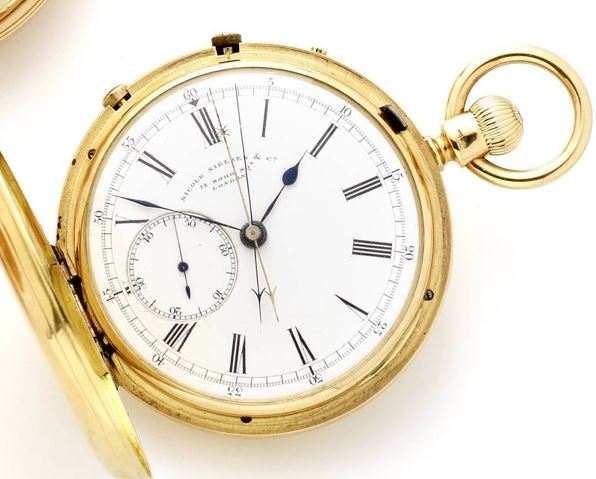In the tiny hamlet of Le Solliat near Le Sentier, Switzerland, two watchmakers, Adolphe Nicole (1812–1876) and Jules Philippe Capt ((1813–circa 1881), came together to form Nicole & Capt in 1837. The early years were marked by innovation and progress. In 1841, they relocated to London and set up business at 80b Dean Street, Soho. According to the 1841 Census, there were five watchmakers residing at this address. By 1844, Nicole & Capt had registered a patent (No. 10,348) for a type of keyless work. revolutionizing watch mechanisms and introducing chronograph functions.
The company’s reputation continued to grow, as evidenced by its participation in prestigious exhibitions. In 1851, Nicole & Capt’s keyless work and repeaters caught the attention of visitors at the London Great Exhibition. Four years later, at the Paris Exhibition, they exhibited under their own name for the first time, solidifying their place among the watchmaking elite. In 1858, Nicole & Capt relocated to larger premises in 14 Soho Square, London.
Further advancements followed, with Nicole & Capt’s patents for stopwatches and timekeepers in 1862, introducing improvements to castle wheels and their first chronograph. The company’s dedication to innovation attracted talented individuals, including Sophus Emil Nielsen, a Danish citizen who joined the company in 1869.
Nicole, Nielso & Co
The subsequent years witnessed a series of notable transitions. At some point prior to 1874, Jules Philippe Capt must have transitioned out of the company, due to retirement or ill-health. In 1874, Nicole & Capt became Nicole, Nielsen & Co, when Sophus Emil Nielson became a partner in the business. The year 1888 brought further change as the company transformed into Nicole, Nielsen & Co Ltd, solidifying its corporate structure and paving the way for future endeavours.

By the late 19th century, Nicole, Nielsen & Co. were making watches for many retailers such as Frodsham, Dent, and Smith & Son. They were known for making high-quality watches, clocks, and chronometers. However, their commitment to excellence remained unwavering. They introduced a new keyless system in 1884 and began manufacturing speedometers in 1904, a venture that proved immensely successful. Sophus Emil Nielson died in 1899. In 1904, working with Smiths, Nicole, Nielsen & Co Ltd began making speedometers for the expanding automobile industry.
World War I brought both challenges and opportunities. The company played a crucial role in supporting the war effort, becoming a major supplier to the government. In 1917, the company underwent another transformation after being acquired by North & Sons Ltd. Despite the changing landscape, the company continued to produce exquisite gold watches to the highest standards in Soho Square. However, the aftermath of the war and the economic crash of 1929 took their toll. Robert Benson North, the company’s manager and director, passed away in this challenging period. Ultimately, in 1933, North & Sons faced financial difficulties and went into receivership.
Related content
Nicole, Nielson & Co at The British Museum